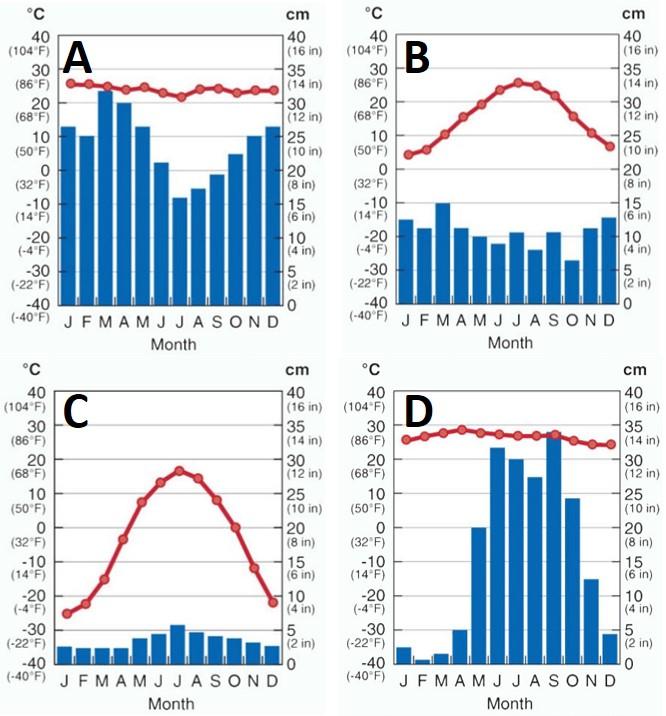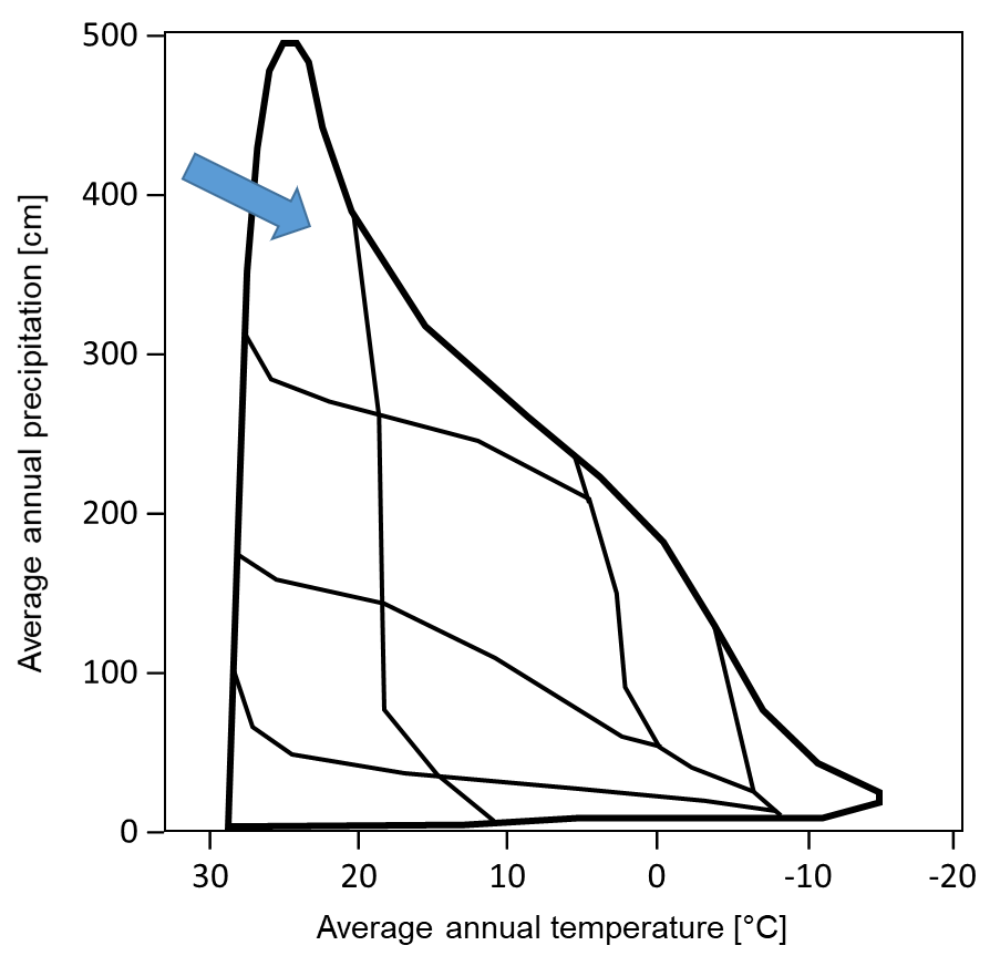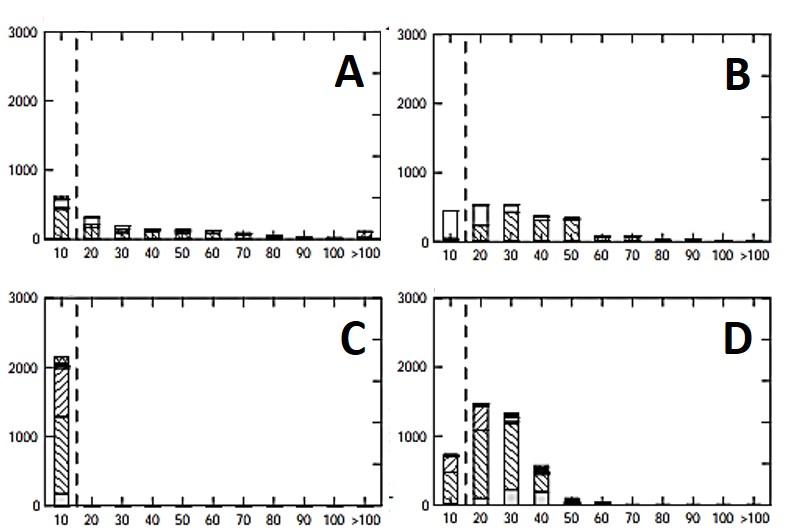Which from below is a tree?
A) Bamboo
B) Oak
C) Palm
D) Grapevine
Answer: B
Which species from below is an angiosperm?
A) Moss
B) Pine tree
C) Apple tree
D) Sea weed
Answer: C
Identify the correct statement about the life cycle of a tree.
A) A tree must reach a certain level of maturity to produce a seed.
B) Angiosperms produce seeds in cones instead of fruit.
C) All trees have both female and male reproductive systems in the same individual.
D) All trees have distinct and independent male and female flowers.
Answer: A
When stems and branches of trees grow in diameter, this is known as:
A) Tertiary growth
B) Cylindrical growth
C) Secondary growth
D) Primary growth
Answer: C
Which from below would be the factor that is least important for plant growth?
A) Light
B) Atmospheric carbon dioxide
C) Temperature
D) Atmospheric nitrogen
Answer: D
If concentration of CO2 in the atmosphere doubled from our current concentration, the effect would be:
A) immediate death
B) increased plant growth
C) no change in growth
D) decreased plant growth
Answer: B
Which of the following is the correct definition of the Botanist perspective of a tree?
A) A woody plant with secondary growth.
B) Big plants that provide habitat, microclimate and participates in ecological cycles.
C) Plants that produce timber.
Answer: A
The most notable characteristic of gymnosperms is that:
A) they only grow naturally in the Northern Hemisphere.
B) their seeds are naked or in a cone.
C) their seeds are enclosed in a fruit.
D) their leaves are most commonly broadleaf.
Answer: B
Which from below can be best considered "plant food"?
A) Carbon dioxide
B) Magnesium
C) Water
D) Nitrogen
Answer: A

Indicate which climate graph above corresponds to a tropical rainforest.
A) A
B) B
C) C
D) D
Answer: A
If you had to pick two climatic variables which best summarize climate itself, which would they be? Pick only 2 from below.
A) Temperature
B) Atmospheric pressure
C) Wind speed
D) Precipitation
E) Solar radiatoin
Answer: A and D
Which forest formation from below occupies the largest area on Earth?
A) Coastal temperate rainforest
B) Tropical rainforest
C) Temperate deciduous forest
D) Boreal forest
Answer: D
Which forest formation from below has been the least affected by human intervention?
A) Tropical rainforest
B) Boreal forest
C) Tropical seasonal forest
D) Montane forest
Answer: B
Identify the false statement about forestry in British Columbia.
A) Most planted forests in BC and in the world are established for commercial purposes.
B) In BC, most commercial timber for the industry comes from native species.
C) BC has one of the most complex forest classifications of Canada, mainly due to their higher diversity.
D) In BC, forests are harvested by the industry and mostly left to regenerate naturally.
Answer: D
One main advantage of planted forests, when compared to natural forests, is that planted forests...
A) have higher biodiversity indices
B) are exotic
C) grow faster
D) are cheaper to produce
Answer: C
What is tree density, also known as stocking density?
A) The dry weight of wood per volume of wood, e.g. kg/m^3
B) The number of trees in a given surface, e.g. trees per hectare
C) The area of a cross-section of a tree at a given height
D) The relative abundance of a given forest formation at the landscape level
Answer: B
What is a bryophyte?
A) A carnivore plant
B) A non-vascular plant popularly known as moss
C) A vascular plant that grows on canopies
D) A fancy word for fern
Answer: B
Which is an attribute of forests, according to the FAO definition?
A) Height higher than 8m
B) More than 50% of individual plants must be trees
C) Canopy cover of more than 10%
D) The tree species in the forest must be native
Answer: C

What biome or formation is indicated with the arrow in the graph below?
A) Hot desert
B) Montane forest
C) Tropical savanna
D) Tropical rainforest
Answer: D
Which from below is not considered forestry at all?
A) Bamboo plantation for engineered products in China.
B) Eucalyptus for pulp production in Uruguay.
C) The boreal forest, since it is so remote no timber extraction takes place.
D) Peach orchard in the Okanagan, BC.
Answer: D
Most biochemical products derived from wood such as rayon or celluloid are extracted from...
A) glucose
B) hemicellulose
C) cellulose
D) lignin
Answer: C
A market demand, in the context of our course, refers to:
A) cellulose
B) forest products that are sold in farmers' markets
C) timber forest products only
D) monetizable forest products and services
Answer: D
The Yasuni ITT Initiative is an example of:
A) A failure at collecting money for conservation
B) An international cooperation to develop new materials from wood fiber
C) A UBC-led project to produce masks from biotextiles to fight COVID-19
D) A revolutionary new transparent material made from wood fibre
Answer: A
Which from below is a non-timber forest product?
A) Maple syrup
B) Plywood
C) Trails for hiking in the forest
D) Cellulose nanocrystals
Answer: A
What is an ecosystem service?
A) Any provision from the ecosystem that benefits people.
B) The biogeochemical processes that ecosystems perform.
C) The resources that the ecosystem provides to all living organisms except for humans.
D) A commercial activity that humans can perform on a given ecosystem.
Answer: A
Ecosystem services are classified in four different categories. To which one does fresh water belong to?
A) Regulating
B) Provisioning
C) Cultural
D) Supporting
Answer: B
What is typically meant by forest zoning?
A) Producing thematic maps that show the different uses of a forest.
B) Making sure the landscape has different types of forests that maximize different ecosystem services.
C) Keeping humans out of protected forests in order to preserve them.
D) The procedure that foresters apply to delineate a forest stand.
Answer: B
From the ecosystem services listed below, which would be the one that you think is the most important for tropical rainforests?
A) Freshwater
B) Timber or fiber
C) Wildlife habitat
D) Fuelwood
Answer: A
If you need a nice-looking table top, which product would you prefer?
A) Particleboard
B) MDF
C) Glulam
D) Edge glued panel
Answer: D
Which product from below is used for both structural and appearance purposes?
A) Glue laminated timber (GLULAM)
B) Dimensional lumber
C) Oriented strand board (OSB)
D) Plywood
Answer: A
Which from below would be the strongest panel, assuming they are all of identical dimensions and similar species?
A) Edge glued panel
B) Plywood
C) Solid wood board
D) Particleboard
Answer: B
When did the economic importance of NTFPs start to be recognized in Canada?
A) 1980s
B) 2000s
C) 1960s
D) 1990s
Answer: D
Why is the definition of NTFPs by FAO limiting?
A) Because it includes services, which are not physical products.
B) Because it fails to account for some NTFPs in certain world regions.
C) Because it excludes smaller, non-industrial products that can be made of wood fiber.
D) Because it suggests that NTFPs need to be extracted in large scales to be economically sustainable.
Answer: C
Which from below is not what we consider a forest disturbance?
A) Logging
B) Flooding
C) Insect infestations
D) Wildfire
Answer: A
Which from below is not an attribute we use to characterize a forest disturbance?
A) Economic loss
B) Agent
C) Frequency
D) Severity
Answer: A
What is the most severe disturbance that affects the boreal forest?
A) Insects
B) Fire
C) Frost
D) Flooding
Answer: B
Approximately how much of forests that burn in Canada each year are known to be caused naturally?
A) 10%
B) 75%
C) 25%
D) 50%
Answer: B
By definition, a forest disturbance is generated by:
A) sensationalist media
B) abiotic and biotic factors
C) natural and human factors
D) human factors
Answer: B
Which of the following disturbances do NOT occur in the coastal forests of BC?
A) Insect infestations
B) Wildfires
C) Hurricanes
D) Landslides
Answer: C
Which is the most important disturbance agent that you need to know about as a starting point to infer about the disturbance regime of a given forest?
A) Wind
B) Flooding
C) Fire
D) Drought
Answer: C
One of the stages of natural forest dynamics is called stand initiation. What do you think triggers stand initiation in general?
A) Defoliator insects
B) Death of old trees by natural causes
C) A disturbance
D) Timber harvesting
Answer: B
Which disturbance from below is most likely to trigger stand initiation?
A) Insect infestation
B) Frost
C) Fire
D) Foliage fungi
Answer: C
Which would be a necessary adaptation that tree seedlings immediately colonizing an area after a disturbance would require?
A) Resistance to fire
B) Resistance to extreme conditions (high solar radiation, wind, etc.)
C) Tolerance to shade
D) Low evapotranspiration capacity
Answer: B
A pioneer tree species is defined as one that first colonizes an area after a disturbance. What do you think is the most important attribute of a pioneer species?
A) Fast growth rate
B) Flat root system
C) Broadleaf
D) Shade-tolerant
Answer: A
What would be the most appropriate metric to measure forest growth?
A) Height differential [m/year]
B) Mean annual increment [m^3/ha/year]
C) Basal area [m^2/ha]
D) Yearly mean canopy closure [%]
Answer: B

Which stand from below is the youngest? The horizontal axes indicate tree diameter [cm] and the vertical axes indicate tree density [trees/ha].
A) A
B) B
C) C
D) D
Answer: C
What is the best definition of a stand-replacing disturbance?
A) A forest fire with high severity.
B) A change from a forest to non-forest state.
C) Damage caused by any factor that adversely affects the vigor and productivity of the forest and which is not a direct result of human activities.
D) A change from an existing forest to a new forest.
Answer: D
What are the 3 components of sustainability in the context of forest management?
A) Monetary, spiritual and practical
B) Economic, social and environmental
C) Predictable, viable and optimal
D) Socioeconomic, ecological and cultural
Answer: B
Which from below is not considered a general objective of forest management?
A) To replace slow-growing forests with fast-growing forests
B) To obtain specific timber forest products
C) To maximize forest growth and health
D) To best resemble natural forest dynamics processes while getting the timber for ourselves.
Answer: A
Which natural stand dynamics phase is resembled by planting after a stand has been harvested?
A) Understory reinitiation
B) Stem exclusion
C) Stand initiation
D) Old growth
Answer: C
Which forest stand from below is more likely to be even-aged?
A) A palm oil plantation in Borneo
B) 20-year-old Douglas fir regeneration after a fire
C) A 150-year old boreal forest affected by a beetle infestation
D) An old growth forest in North Vancouver
Answer: B
Which of the following is not a silvicultural treatment?
A) Clearcutting
B) Thinning
C) Site preparation
D) Pruning
Answer: D
In which natural stand dynamics phase may thinning be most appropriate to promote the growth of individual trees within a stand?
A) Old growth
B) Stand initiation
C) Stem exclusion
D) Understory reinitiation
Answer: C
Which from below is not an advantage of the seed tree silvicultural system?
A) Regeneration is expected to be well adapted to the site due to genetics of parent trees.
B) Lower establishment costs.
C) Aesthetically better than clearcutting.
D) Less skill required than any other silvicultural system.
Answer: D
What differentiates clearcutting and shelterwood?
A) The regeneration method
B) The number of harvesting interventions
C) The species planted
D) The target stand structure
Answer: B
Which silvicultural treatment from below is generally the one that generates the most environmental concerns?
A) Thinning
B) Pruning
C) Harvesting
D) Planting
Answer: C
A certain type of forest is affected by an insect defoliator that attacks a very high percentage of mid-sized trees within the stand (with a DBH averaging 50 cm and height of 35 m). These trees are abundant within the stand but suffer severe growth rate reductions due to the defoliation and significant mortality within 2 to 3 years after the infestation starts. Which silvicultural operation may be well justified to best emulate natural disturbance regimes?
A) Pruning of branches affected with the defoliator.
B) Commercial thinning of the defoliator.
C) Protection of the stand (do nothing), as these defoliators would not lead to stand initiation.
D) Clearcutting of the entire stand to stop the defoliator from spreading.
Answer: B
What was the main cause of the notable rise of the area occupied by second-growth/regeneration today compared to the original forest cover of Vancouver Island?
A) Urbanization
B) Logging
C) Conversion to agriculture
D) Unprecedented infestations in the past century
Answer: B
What is the predominant natural disturbance regime that best explains regeneration and growth in the coastal temperate rainforests of British Columbia?
A) Fire
B) Landslides
C) Tree fall
D) Defoliators
Answer: C
What is a forest policy?
A) Official laws that apply to forestry activities.
B) A negotiated agreement amongst the government and relevant stakeholders on a shared vision and goals for a country's forests and trees, adopted by government.
C) The strategies a jurisdiction applies to select silvicultural systems for their forests.
D) The annual roundtable that FAO executives participate on to define forestry terms
Answer: B
Who is the biggest legal landowner of land and forests in British Columbia?
A) Private forestry companies
B) Municipal Governments
C) The Federal Government
D) The Provincial Government
Answer: D
Who is licensed to harvest most of timber volume in BC?
A) Private forestry companies
B) Foreign timber wholesalers
C) The government itself
D) First Nations
Answer: A
Which is the most important piece of legislation that regulates forest operations in BC?
A) The Timber Extraction Bylaws
B) The Forest Act
C) The Forest and Range Practices Act
D) The Provincial Forest and Wildlife Constitution
Answer: C
Which from below is not really a problem for the forestry sector in BC?
A) Government understaffing
B) Relatively low diversity of species used for reforestation
C) Slow responses to needed policy changes
D) Illegal logging
Answer: D
87% of Guyana's forests are made up of this forest type.
A) Deciduous temperate forest
B) Temperate rainforest
C) Tropical rainforest
D) Boreal forest
Answer: C
Which of the descriptions below best match how forestry is organized in British Columbia?
A) The government provides harvesting licenses to third parties (mostly big companies), and gets stumpage fees in return.
B) Most of the harvesting in the province is done by First Nations in their land, who pay taxes to the government.
C) Private companies, public companies, and First Nations have a relatively equal share of timber harvesting.
D) The government owns the land and executives harvesting, employing thousands of private citizens.
Answer: A
What percentage of land is owned by the government in British Columbia under the current legal system?
A) 95
B) 50
C) 0
D) 5
Answer: A
Which characteristic below is the least associated with forestry in Guyana?
A) Land ownership predominantly in the hands of foreign multinational corporations.
B) Little benefit to local communities.
C) Government authoritarianism in forest management.
D) Rampant corruption.
Answer: A
A specific characteristic of an area-based tenure is:
A) Licensees are rented land for afforestation and reforestation purposes.
B) Licensees are given exclusive rights to an area.
C) Licensees are allocated an annual allowable cut.
D) Licensees operate within a given Timber Supply Area.
Answer: B
Which from below is a storage component of the hydrologic cycle?
A) Precipitation
B) Overland flow
C) Atmospheric vapor
D) Evapotranspiration
Answer: C
According to the simplified water balance equation, if on a given year in a watershed the streamflow was 250mm and evapotranspiration was 550mm, how much did it rain on that year?
A) 800mm
B) 2.2mm
C) The calculation is not possible because more factors are involved
D) 220%
E) 300mm
Answer: A
Which from below would be the factor least affected by typical forest operations, generally speaking?
A) Flooding risk
B) Stream temperature
C) Sediment load
D) Streamflow
Answer: B